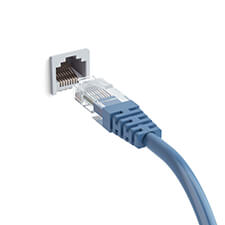Ethernet
Ethernet, pronounced "E-thernet" (with a long "e"), is the standard way to connect computers on a network over a wired connection. It provides a simple interface and for connecting multiple devices, such computers, routers, and switches. With a single router and a few Ethernet cables, you can create a LAN, which allows all connected devices to communicate with each other.
A standard Ethernet cable is slightly thicker than a phone cable and has an RJ45 connector on each end. Ethernet ports look similar to telephone jacks, but are slightly wider. You can plug or unplug devices on an Ethernet network while they are powered on without harming them.
Like USB, Ethernet has multiple standards that all use the same interface. These include:
- 10BASE-T - supports up to 10 Mbps
- 100BASE-T - supports up to 100 Mbps
- 1000BASE-T (also called "Gigabit Ethernet") - supports up to 1,000 Mbps
Most Ethernet devices are backwards compatible with lower-speed Ethernet cables and devices. However, the connection will only be as fast as the lowest common denominator. For example, if you connect a computer with a 10BASE-T NIC to a 100BASE-T network, the computer will only be able to send and receive data at 10 Mbps. If you have a Gigabit Ethernet router and connect devices to it using 100BASE-T cables, the maximum data transfer rate will be 100 Mbps.
While Ethernet is still the standard for wired networking, it has been replaced in many areas by wireless networks. Wi-Fi allows you to connect your laptop or smartphone to a network without being tethered to the wall by a cable. The 802.11ac Wi-Fi standard even provides faster maximum data transfer rates than Gigabit Ethernet. Still, wired connections are less prone to interference and are more secure than wireless ones, which is why many businesses and organizations still use Ethernet.
NOTE: Ethernet is also known by its technical name, "IEEE 802.3."
 Test Your Knowledge
Test Your Knowledge